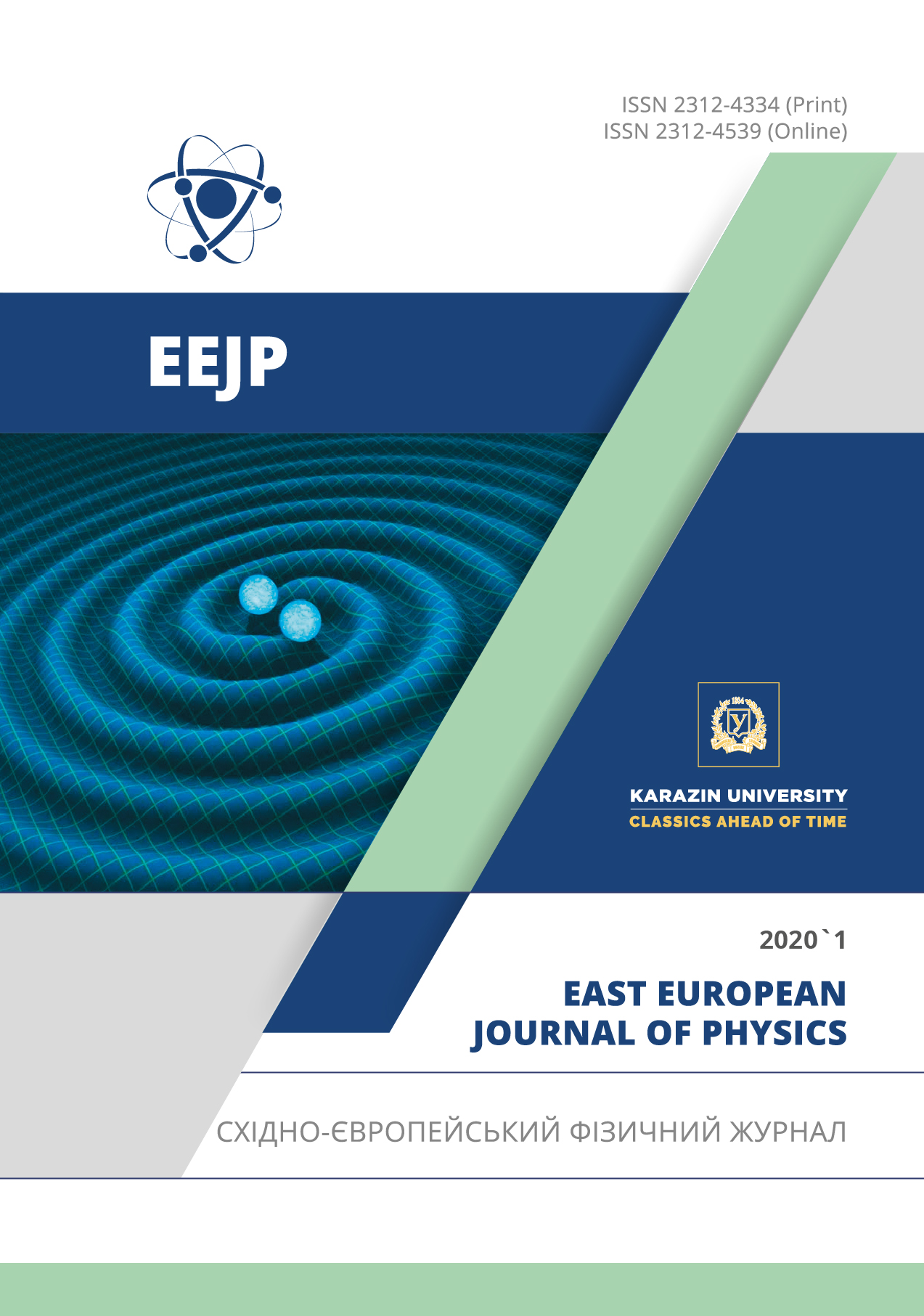Effect of Kind of Deformation on Young's Modulus, Damage Parameter, Texture and Structure of Alloy Mg – 5% Li (wt)
Abstract
Effect of deformation by extrusion, rolling after extrusion (in combination with annealing and changing the rolling direction), and subsequent alternating bending (AB) with the number of cycles 0.5, 1, 3, and 5 on the elastic modulus (E), damage accumulation parameter (damage parameter ω), crystallographic texture, and substructure parameters of the binary Mg-5%Li alloy have been studied. The damage parameter (0 ≤ ω ≤ 1), which is interpreted as the relative reduction in the effective load-bearing cross-sectional area due to damage accumulation, was found by the change in the elastic modulus after various above types of deformation. At this, we used to compare equivalent deformation and equivalent elastic energy models. The substructure parameters (crystalline domains sizes D, lattice distortion ε, dislocation density ρ) were estimated by analyzing the physical broadening of the lines diffraction on the crystal lattice of studied alloy of the penetrating hard X-ray synchrotron radiation. It was found that in the studied alloy, sheet forms a texture, at which the hexagonal prism axis is 90° deviated from the normal direction (ND) to the sheet up to transverse direction (TD) after extrusion of the ingot at 350°C in combination with its further rolling in the direction of extrusion axis (rolling direction RD) to a thickness of 4.5 mm and annealing at 350°C after each pass. At this the crystallographic directions and coincide with RD. The texture, at which the hexagonal prism axis is deviated from ND to TD by angles ranging from 15 to 70° (unlike from texture of basal type of the pure magnesium) is formed after further rolling of studied alloy to a thickness of 1 mm with the changing of the RD on 90° in combination with annealing at 350°C after each pass. The crystallographic direction coincides with RD. The anisotropy of above mentioned characteristics was found. Correlation and regression analysis showed that the anisotropy and the values of E, D, ε, and ρ, are decreased, and the values of ω are increased with an increase of alternating bend cycles’ number. It is shown that changes in the above characteristics are mainly due to the crystallographic texture formed during thermomechanical processing and subsequent alternating bending of Mg-5%Li alloy sheets, which is confirmed by data of correlation and regression analysis.
Downloads
References
Z. Yang, J.P. Li, J.X. Zhang, G.W. Lorimer, and J. Robson, 21(5) 313-326 (2008), https://doi.org/10.1016/S1006-7191(08)60054-X
L. Ruihong, P. Fusheng, B. Jiang, D. Hanwu and Y. Qingshan, Materials Science & Engineering A, 562, 33–38 (2013), http://dx.doi.org/10.1016/j.msea.2012.11.032
K. Alaneme, and E. Okotete, Journal of Magnesium and Alloys, 5 (4), 460-475, (2017), https://doi.org/10.1016/j.jma.2017.11.001
H. Hafekamp, M. Niemeyer, R. Bohem, U. Holzkamp, C. Jaschik and V. Kaese, Material Science Forum, 350-351, 31-42 (2000). https://doi.org/10.4028/www.scientific.net/MSF.350-351.31
Methods of leveling sheet metal https://blog.arku.com/us/methods-of-leveling-sheet-metal/
N. Shkatulyak, S. Smirnova, and V. Usov, Hindawi Publishing Corporation, International Journal of Metals, Article ID 349810, 8 pages, (2015). http://dx.doi.org/10.1155/2015/349810.
L.M. Kachanov, Основы механики разрушения [Fundamentals of fracture mechanics], (Nauka, Moscow, 1974), 312 p. https://lib-bkm.ru/13776 [in Russian].
Y.N. Rabotnov, Избранные произведения. Проблемы механики деформируемого твердого тела [Selected works. Problems of the mechanics of a deformable solid], (Nauka, Moslow, 1991, 196 p.) [in Russian].
J. Lemaitre, R. Desmorat, and M. Sauzay,. Eur. J. Mech. A, 19 (2), 187-208, (2000). https://www.sciencedirect.com/science/article/pii/S0997753800001613
N.R. Hansen, and H. L. Schreyer, Int. J. Solid. Structures, 31 (3), 359-389, (1994). https://kopernio.com/viewer?doi=10.1016/0020-7683(94)90112-0&token=WzM3NTM2LCIxMC4xMDE2LzAwMjAtNzY4Myg5NCk5MDExMi0wIl0.IbXai4W6T9jPyaO_4p_S86QIzV8
C.L Chow, and J. Wang, International Journal of Fracture, 33, (1) 3-16, (1987), https://link.springer.com/article/10.1007/BF00034895.
M. Bobyr, O. Khalimon, and O. Bondarets, Journal of Mechanical Engineering NTUU «Kyiv Polytechnic Institute», 67, 5-13, (2013). http://nbuv.gov.ua/UJRN/VKPI_mash_2013_67_3
V.V. Usov, and N.M. Shkatulyak, Russian Physics Journal, 47, (11), 1139-1146, (2004), https://www.researchgate.net/publication/226984093_Fractal_nature_of_the_dislocation_structure_of_low-alloyed_steel_after_controlled_rolling
Technical Review ITC-ME/ATCP (2010). http://www.atcpndt.com/images/products/sonelastic/articles/RT03-ATCP.pdf.
H.-G. Brokmeier, S. Yil, N. Park and J. Homeyer. Electron Resource, Solid State Phenomena105, 55–60, (2005), http://www.scientific.net/SSP.105.55
H.-G. Brokmeier, Sangbong Yi, Textures in Engineering Materials: From Fundamentals to Applications, in Neutrons and Synchrotron Radiation in Engineering Materials Science, (2017) pp.55-72, Wiley-VCH
FIT2D: An introduction Overview. http://www.esrf.eu/computing/scientific/FIT2D/FIT2D_INTRO/fit2d.html
G. Williamson and W. Hall Acta metallurgica, 1(1), 22-31 (1953). http://www.xray.cz/xray/csca/kol2011/kurs/Dalsi- cteni/clanky/Williamson-ActaMet-1953-1-22-WH-Plot.pdf
T. Ungár, and J. Gubicza, Ultrafine Grained Materials II, 595–604, (2013), https://core.ac.uk/download/pdf/11856593.pdf
P.R. Morris, Journal of Applied Physics, 30, (4), 595-596, (1959), https://doi.org/10.1063/1.1702413
C. Dragomir, and T. Unga´r, J. Appl. Cryst., 35, 556–564, (2002). https://doi.org/10.1107/s0021889802009536
H.B. Huntington, Solid State Physics, 213–351, (1958). https://doi.org/10.1016/S0081-1947(08)60553-6
N. Shkatulyak, V. Usov and S. Smirnova, International Journal of Advances in Materials Science and Engineering, 4(4), 1-11, (2015), https://www.researchgate.net/publication/283650995_Single_Crystal_Magnesium_Lithium_Alloy_Elastic_Constants
A. Borbely, http://metal.elte.hu/anizc/.
Gubicza, N.H. Nam, K. Mathis, and V.V. Stolyarov, Z. Kristallogr. Suppl., 23, 93-98, (2006), http://gubicza.web.elte.hu/publikaciok/epdic9_sajat.pdf
J.J. Kearns, Journal of Nuclear Materials, 299(2), 171–174 (2001), https://doi.org/10.1016/S0022-3115(01)00686-9.
V. Grytsyna, D. Malykhin, T. Yurkova et al. East Eur. J. Phys. 3, 38-45 (2019), https://doi.org/10.26565/2312-4334-2019-3-05.
N.V. Ageev, A.A. Babareko and S.Ya. Betsofen, Izv. Ross. Akad. Nauk, Ser. Met. 1, 94–103 (1974).
Authors who publish with this journal agree to the following terms:
- Authors retain copyright and grant the journal right of first publication with the work simultaneously licensed under a Creative Commons Attribution License that allows others to share the work with an acknowledgment of the work's authorship and initial publication in this journal.
- Authors are able to enter into separate, additional contractual arrangements for the non-exclusive distribution of the journal's published version of the work (e.g., post it to an institutional repository or publish it in a book), with an acknowledgment of its initial publication in this journal.
- Authors are permitted and encouraged to post their work online (e.g., in institutional repositories or on their website) prior to and during the submission process, as it can lead to productive exchanges, as well as earlier and greater citation of published work (See The Effect of Open Access).








